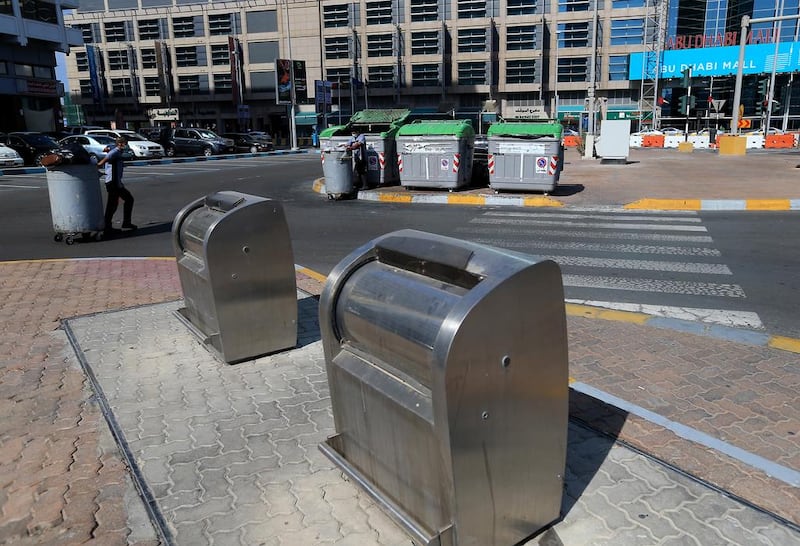ABU DHABI // Underground rubbish bins installed for what is believed to have been millions of dirhams are lying unused and an eyesore, residents say.
The bins were introduced in 2009 and dozens were installed across the capital by 2011.
But of 10 of the machines inspected during the week, only one was working.
Residents complained of unhygienic conditions around the bins.
“I thought these steel bins are for throwing cigarette butts. I didn’t know that they are for dumping garbage,” said Ali Nasir, 30, an Indian resident of Al Zahiyah.
“Never I have seen anybody depositing waste in them. Everybody just dumps the garbage at regular big bins.”
Eight of the machines inspected were installed close to Abu Dhabi Mall in Al Zahiyah, formerly known as the Tourist Club Area, and one off Zayed the First Street near the Etisalat tower. None were functioning.
But one bin was working in Khalidiya opposite the Adnoc petrol station.
The bins were installed by Tadweer, the Centre for Waste Management, in 2009 and the hydraulic bin system was set to expand across the emirate.
Access to the bins is through a receiver unit at street level, in which rubbish is deposited. The containers are encased in a metal frame and sunk inside a concrete sleeve.
The bins were designed to serve pedestrians, street cleaners and small shops and to remove many of the health hazards, such as flies breeding and foraging by stray cats.
They were also supposed to cut the number of trips made by rubbish lorries, reducing costs, fuel and the carbon footprint.
The centre announced in 2009 that the underground system would be installed as a pilot project at 31 sites, including Khalidiya, Al Zahiyah and Al Ain.
The sites were chosen for reasons including volume of waste generated and population density.
Another Al Zahiyah resident, Raafat Hameed from Pakistan, said he had never seen the bins operating.
“I always use these bins,” Mr Hameed said, pointing to the regular ones. “I haven’t seen them operational. I have seen such steel boxes in other locations of the city too but didn’t find them functional.”
An Electra Street resident, Mohammed Khawaja, said the units were an eyesore.
“I think two years back it was open but I never used it,” said Mr Khawaja, 50, also from Pakistan. “Then it was barricaded with wooden boxes.
“People leave their plastic bags and cartons beside it while others throw grain for pigeons, which only adds to the unhygienic conditions.
“I wonder why it has been unused for a few years. No maintenance or attention has been paid to it.
“I have seen such units in other localities but didn’t see anybody dumping rubbish in them.”
The machines were originally fitted with sensors that sent an alert to the waste centre when they were full.
Specially adapted lorries would then lift them up, emptying the containers and replacing them.
The centre also had announced that the underground system would provide centralised and strictly regulated rubbish collection, while preventing unauthorised dumping of waste.
But at the only bin found to be working, in Khalidiya, anyone could dump their rubbish.
Radhwan Haswan, 42, a resident in the area uses the bins, said they were a good idea.
“It’s working,” the Egyptian said. “The rubbish collectors have a remote control to open it and clear the underground bins.”
Mr Haswan said the system prevented bad odours.
The Centre for Waste Management did not respond to queries for comment.
anwar@thenational.ae





